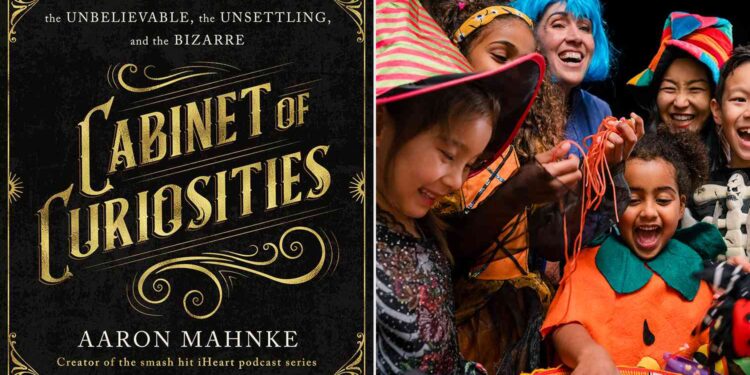:max_bytes(150000):strip_icc():format(jpeg)/Cabinet-of-Curiosities-Candy-Corn-Essay-102524-tout-8245caa7fb9a414fbe38ac1b50325ad8.jpg)
There’s a great debate that happens each October: what’s the best Halloween candy? Plenty of people jump in right off the bat with Reese’s, or Snickers, or KitKats — maybe Sour Patch Kids or Gummy Bears if you want something fruity. Me, I’ll always remember the popcorn balls that my next-door neighbor handed out each year.
But how did we get here, anyway? Where did this idea of walking door to door for candy hand-outs actually come from? Well, Halloween actually originates from Samhain, an ancient Celtic harvest festival that was celebrated between Oct. 31 and Nov. 1. The Celts believed that the boundary between our world and the spirit world was thinnest on those days, and that residents of the netherworld could cross into this one to wreak some havoc.
To bring order to the chaos, participants left offerings outside the village for any fairies, spirits or monsters that might make an appearance. Bonfires were lit, and later — during the Middle Ages — little carved turnips called Jack-o-Lanterns began cropping up to ward off evil.
St. Martin’s Press
According to some sources, people also disguised themselves in costumes made of animal hides in an attempt to scare away those unwelcome ghostly visitors. And over time, it evolved into a practice called “souling.” This was when the poor folks in each community would visit the wealthy households where they would receive little cakes in exchange for a prayer.
This later became a kid-only experience, where these children dressed up in costumes and — after knocking on a door — traded a song, a poem or a joke for a snack.
Modern-day Halloween fully took shape in the United States with many communities organizing group trick-or-treating in the early 20th century. The trend took a short break for World War II, and in the baby boom that followed it, many of the Halloween traditions we know and love today became a cemented part of the culture.
Among the candies that are handed out today is one that’s far older than you would probably guess. In fact, one version can trace its roots all the way back to Philadelphia in the 1880’s. That was where a man named George Renninger worked for the Wunderle Candy Company. And he had a wild new idea.
svetikd/Getty
He proposed they mold buttercream into the shape of harvest vegetables. Shapes like chestnuts, turnips, corn and pea pods, all meant to appeal to America’s agricultural roots. And while all of them sounded great, the corn was the easiest shape, so that came first. We’re not sure what the original recipe was, but it was probably some mixture of sticky sugar and corn syrup.
Renninger worked hard to perfect the candy’s recipe and shape. His grandson later told a newspaper that his granddad threw batches of it out to the family chickens and knew it was the perfect shape once the chickens started going after it. He figured if the chickens were fooled into thinking it was real corn, he had nailed it.
In a nod to that goal, when the Goelitz Confectionery Company picked up his recipe, they marketed it as “Chicken Feed,” complete with a big rooster on the front of the box. And soon enough, they were one of the largest producers of buttercream corn in the country. And they achieved that, in part, by using color.
The PEOPLE Puzzler crossword is here! How quickly can you solve it? Play now!
Each section of the candy was poured by hand in order to keep the colors separate and distinct. This process involved factory workers carrying heavy buckets filled with the candy mixture, who then walked backwards along a conveyor belt full of trays. And when I say heavy, I mean it; some of these buckets could weigh up to 200 pounds.
Thankfully, this labor-intensive corn wasn’t produced year-round. Part of the reason was to give the workers a rest, but it was also to create a link in the minds of the American people. “Chicken Feed” was meant to tap into the joys of a bountiful harvest, which later helped connect it with Halloween.
But not at first.
Instead, it was supposed to be a gag candy, a joke or a novelty. You see, the name “Chicken Feed” was pretty literal. Most Americans saw corn as food for livestock, not people. It wasn’t until after World War I that people started eating the vegetable in the same way we do today, and even then, it was mostly out of necessity.
mphillips007/Getty
As a result, Goelitz could barely keep boxes on the shelves. In an era before machine automation, it was hard to meet demand. Thanks to modern mechanization, though, their production hit a new high in the 1950s. And along the way, they realized that the old agricultural roots of their candy had faded into the past. A new name was needed for their delicious treat, and it was eventually rebranded for the modern world.
The bright colors and a catchy new name helped the candy secure its spot as a staple of Halloween, and there it remains to this day. Sure, it might be one of the most divisive candies in America, and have a shelf life longer than a Twinkie, but you have to admit: Halloween just wouldn’t be the same …
…without Candy Corn.
Never miss a story — sign up for PEOPLE’s free daily newsletter to stay up-to-date on the best of what PEOPLE has to offer , from celebrity news to compelling human interest stories.
Aaron Manke’s new book, Cabinet of Curiosities: A Historical Tour of the Unbelievable, the Unsettling, and the Bizarre comes out Nov. 12 and is available for preorder now, wherever books are sold.







